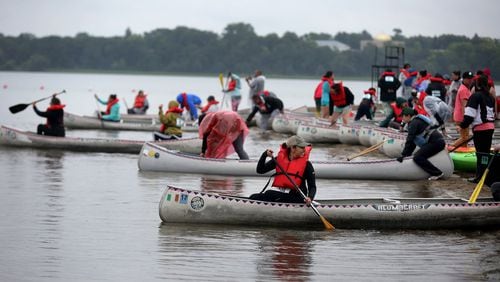MINNEAPOLIS — The players stood on the field in a circle, passing burning sage to one another.
One by one, they waved their lacrosse sticks over the thick, sweet-smelling smoke.
Then they faced off, ready to start play on a recent Sunday at Corcoran Park in Minneapolis. Sasha Houston Brown tossed up the ball. The other players jumped for it — raising their sticks toward the sky and shouting excitedly “to let Creator know we’re playing,” Houston Brown said.
It’s a scene that plays out each week in the park among the dozen or so Native Americans who regularly show up to play old-style lacrosse, or “Creator’s game,” as they call it.
For them, it is more than a game. It’s medicine.
The prescription for better health for Native Americans lies in returning to their roots, Houston Brown and Lisa Skjefte believe. The Minneapolis women are among a new generation of Native health advocates working to improve community health by reviving the active lifestyle of their ancestors.
“We had all of this down,” Skjefte said. “We know how to survive.”
Staggering rates of obesity and diabetes among Native Americans have led to shortened life spans. Native adults are twice as likely to be diagnosed with diabetes as is the general population, according to the U.S. Centers for Disease Control and Prevention.
Diets worsened when Native Americans were forced to live on reservations and government commodities replaced the nutrient-rich, natural foods they were used to eating. Physical fitness waned as lacrosse was lost to the Indigenous people who invented it.
“It was something that was very deliberately taken from us,” Houston Brown said.
But now, Native Americans are reclaiming the game and playing it as their ancestors did to support good health.
“It brings out people who would not normally come out for sports,” said Houston Brown, 30, a leading voice for the revival of lacrosse among Native Americans. “We know each other’s kids and each other’s families. It builds community, which is the foundation of health in many ways.”
Across town, Skjefte led a group of fellow Native women last month on a brisk walk around Lake Calhoun, which is also known by its Dakota name, Bde Maka Ska. Meanwhile, other Native women raced canoes. Skjefte smiled at the sight of the hundreds of participants in the Kwe Strong Triathlon — an event she co-founded six years ago to encourage Native women and girls to be healthy and strong.
“We want to transform fitness in a Native way,” Skjefte said.
TWO WOMEN, ONE PASSION
Getting the Native American population to exercise more isn’t easy.
“In our communities, we see a lot of our people struggling still,” said Skjefte, a citizen of the Red Lake nation Band of Ojibwe.
Going to the gym can feel foreign. But stepping into a canoe and being outside, that’s natural, she said.
“By going back to these traditional activities, it seems like [these are] natural pathways. We don’t have to convince anyone to get into a canoe. They want to.”
The idea for the Kwe Strong Triathlon came to Skjefte while she was on a long run.
“I could just see all the women on the lake. I could see us canoeing together,” she said. “I knew that canoeing would be the thing that would make it ours.”
Houston Brown’s passion for lacrosse began when she was a student at Blake High School. At the time, she didn’t know about the game’s origins. After graduating from Carleton College, she learned that it was invented by Native Americans, which led her to start playing again.
Her effort to resurrect the traditional game feeds her larger passion for Indigenous health and wellness.
“I keep coming back to that,” said Houston Brown, whose mother is of Russian ancestry and whose father is Dakota, Santee Sioux. “If we are not well spiritually, emotionally and physically, we aren’t able to participate in other spheres.”
She speaks from harrowing personal experience. When she was in college, she was sexually assaulted. Strength training and physical activity played a key role in her physical and mental recovery, she said.
“Over the course of many years, therapy and ceremony, I began to heal,” Houston Brown said. “Learning to be present in my body, to appreciate all that I am physically capable of doing and connecting with other women around health is truly what has allowed me to thrive.”
She stays in shape by running, playing Creator’s game and lifting weights. She leads strength training classes on a weekly basis that are open to Native women and, especially, girls. Making intergenerational connections, she explained, is linked to better health outcomes and is a part of the culture.
GAME WAS A GAME-CHANGER
Back at Corcoran Park, the oldest player on the field this day was in his early 50s and the youngest was a 9-year-old boy.
“The feeling you get when you move through seven or eight people and score, the rush you feel — it’s amazing,” said David “Bezh” Butler, 36, a regular at the lacrosse gatherings.
Picking up the sport was a game-changer for his health. He used to spend his free time in his Minneapolis home playing video games. Then he heard about a lacrosse practice and decided to try it.
“When I first came, I didn’t know anybody,” he said. And he couldn’t keep up with everyone. “I was running out of air,” he said.
But he stuck with it and soon, Butler was playing for four hours at a stretch. During that time, he says, he dropped 40 pounds.
“It really made me think about my health,” he said. “It really centered me.”






